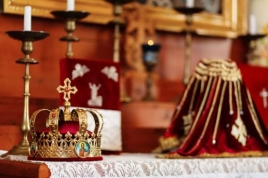Armenian Family Life - Armenian Culture
Friday, September 16, 2022
Armenian Culture
Armenian religion, family life, and the rituals and traditions expressed in their culture have played a powerful role in helping Armenians around the world hold on to a strong sense of identity and heritage.
Christianity
Armenia proudly claims the distinction of being the first country to adopt Christianity as a state religion. Tradition has it that two of Jesus’s Apostles, Thaddeus and Bartholomew, successfully preached Christianity to Armenians as early as AD 40. In 301, Christianity was declared the official religion, and a church was built at Etchmiadzin, which today is a UNESCO World Heritage site. Armenians are proud that their homeland is the location of Mount Ararat, which may have been the resting place of Noah’s ark after the flood, and other Biblical events.
As the unique Armenian alphabet developed in the 5th century, so did a flowering of Christian religious literature. Armenian religious scholars made important contributions to the wider Christian world. Translations of key scriptural texts by early Armenian scholars are now some of the earliest versions available.
Throughout the past 1,000 years, Armenians who migrated out of the country have taken their faith with them. When the Kingdom of Armenia fell in 1375, the church not only survived, but it assumed a leadership role that helped keep Armenian identity alive. Today, the Armenian Apostolic Church numbers between 8 and 9 million members. This membership includes about 94 percent of the population of the country, more than 3.5 million members in Europe, and more than a million members in the United States.
Family Life
Armenian culture celebrates families and family life. Weddings no longer last for several days, but they are still lively affairs filled with joyous rituals. Extended families of both bride and groom play important roles; a godparent couple serves as witnesses and role models. At church wedding services, a priest crowns the couple to symbolize the creation of their “little kingdom” as a family. Dancing, music, and food follow, and large numbers of friends and family bestow generous gifts.
Wedding rituals express hope that the marriage will be blessed with children. Traditional Armenian families welcome many children. The community celebrates birth with music and by decorating the infant’s home with green branches that symbolize the continuity of the family. There is even a formal celebration when a baby’s first tooth appears. This love for children outlasts childhood; extended families may live together or visit each other frequently. The family unit is so important that Armenian names often identify an ancestor or ancestral place, which can help those who are researching their Armenian family history.





